2022 Review of Spectroscopic Instrumentation
We present our annual review of products introduced at Pittcon or during the previous year, broken down by the following categories: atomic spectroscopy, ultraviolet and visible (UV-vis), near-infrared (NIR), infrared (mid-IR), Raman, imaging, nuclear magnetic resonance (NMR), mass spectrometry (MS), accessories, and components.
Between the online Pittcon event of 2021 and the time this review was written, a lot has changed. We all anticipated an in-person Pittcon for 2022; unfortunately, that did not happen because of a surge in Covid cases in the southeastern United States where the event was going to be held. As a result, Pittcon 2022 was converted into a virtual conference. But the fact that one of the “introduction points” for new spectroscopy instruments did not happen live did not stop the launch of exciting new spectroscopic instruments in the past year.
However, it does seem that the Covid pandemic may have reduced the number of recent new product introductions. In our 2021 review, we reported on almost 100 products introduced by more than 50 companies. This year, the number of both companies and products was significantly smaller. Table I lists the companies that responded to our request for information about new products introduced over the past 12 months.
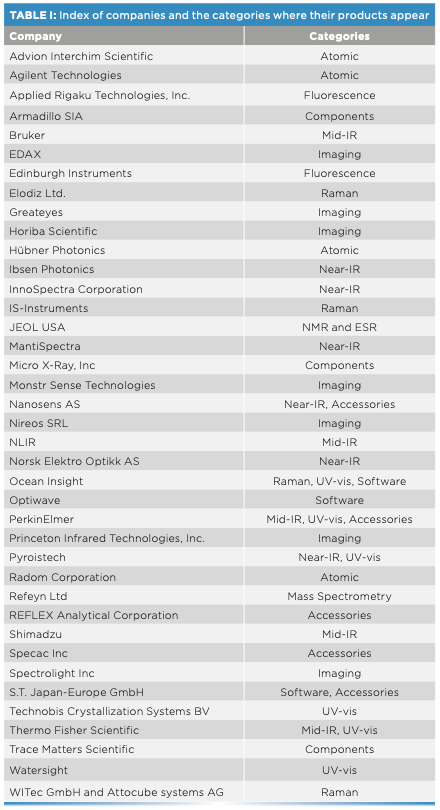
Considering the volume of products usually covered in these reviews, it seems clear that we have the pandemic to blame for the lower number of products we see this year. Over the past two years, engineering teams have had to cope with product development in either a socially distanced or remote way. The ability of such product development teams to function during the pandemic is remarkable, and it especially impressive that some teams were able to introduce several new instruments to the market.
A few live analytical chemistry and spectroscopy conferences were held in the latter half of 2021 as we thought the pandemic was winding down. For those who attended, it was gratifying to speak face-to-face with each other. Some of the products mentioned here and some in our 2021 review were available to see in person at those shows. So far this year, one in-person conference has occurred, the American Chemical Society (ACS) Spring 2022 conference in San Diego, and some of the new equipment mentioned in this year’s review was shown at that event.
Over the last few years, we have seen more analyzer tools entering the market, looking to solve specific questions. Several new products this year are extending this approach to agricultural and environmental applications. Additionally, we noted in the last few years how software is evolving into a true laboratory partner. By integrating more artificial intelligence (AI) and by targeting specific applications, such as microplastics analysis, software is becoming a more powerful tool, especially when directed at one application even when the core hardware technology may be similar to that of previous generations. Even the visualization of data is being used powerfully to extract trends and subtle changes.
In this year’s review, we have taken a somewhat different approach than in years past. The tables contain a significant amount of information about the products, but the text only highlights the unique products or trends. As a result, our discussion does not cover every product in detail. For detailed information regarding the individual products, refer to the tables throughout this review.
Our discussion is broken into four sections: instrumentation, accessories, components, and software. The difference between an accessory and a component is that an accessory is designed to be used with a completed instrument whereas a component can be used to construct an instrument. The tables associated with this article are grouped (when possible) by spectral range and application.
Instrumentation
Although some of the new instruments introduced in the past year are more general in their application, many of the new products are geared to special applications. We have seen this trend toward specific task-oriented tools in recent years, as we have noted previously.
Table II contains information on all the atomic products that were submitted. On the instrument side of the “Atomic Spectroscopy” category, Radom Corporation has introduced a new inductively coupled plasma (ICP)–optical emission spectroscopy (OES) instrument that is argon-free, operating with microwave-sustained atmospheric plasma. This device is so small that it is considered portable. Another laboratory-based ICP instrument is the Solation ICP-mass spectrometry (MS) system from Advion Interchim Scientific. The design appears to be good for complex samples, which could broaden the utility of the instrument and minimize sample preparation. Applied Rigaku Technologies, Inc. introduced a new X-ray fluorescence (XRF) instrument.

Agilent Technologies has introduced an environmentally friendly coolant fluid, and Hübner has introduced a new laser source for laser-induced breakdown spectroscopy (LIBS).
In the “UV-vis” category (Table III), several interesting products have been introduced into the market this past year. Although all of them are full instruments, they can be divided by form factor and application.
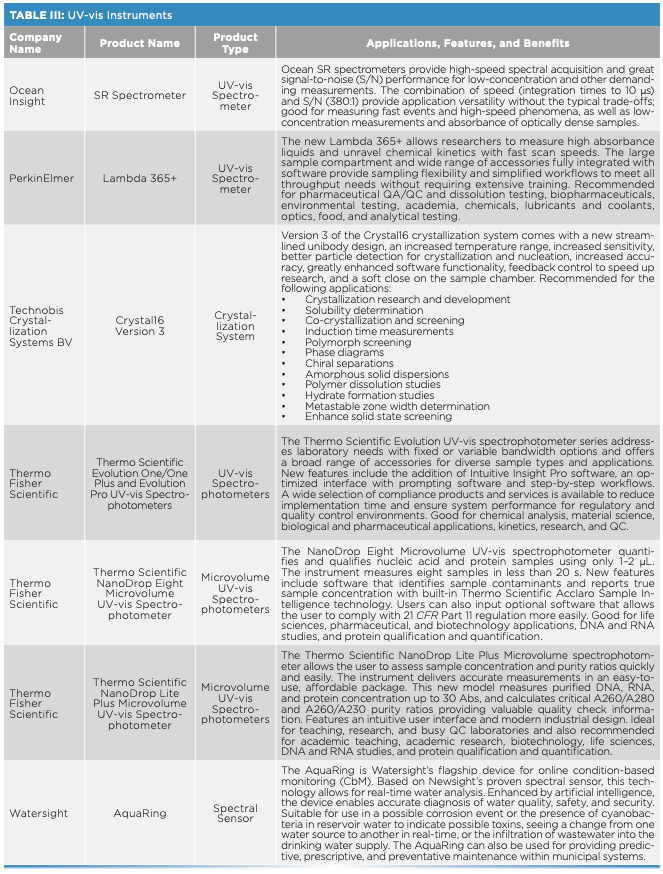
PerkinElmer and Thermo Fisher Scientific have both introduced laboratory-based UV-vis instruments. Perkin Elmer’s Lambda 365 and the Thermo Fisher Scientific Evolution products are designed for general spectroscopy applications and provide flexibility because they can use various accessories for maximum problem-solving capability. Other instruments, like the Thermo Fisher Scientific Nanodrop, are designed for laboratories where the sample volumes are very small, and the applications are typically customized to the life sciences.
Technobis Crystallization Systems BV has introduced a system, the Crystal16 version 3, with a single application: to measure changes in crystallization and crystallization behavior.
On the other end of the form factor consideration, Ocean Insight and Watersight have introduced small-form-factor devices. The Ocean Insight SR spectrometer continues in the same way as most of Ocean Insight’s products, with a high speed, compact design.
An interesting new entry in the market from Watersight is a self-contained visible and very near-infrared (NIR) device, called Aquaring, that can continuously monitor water quality by collecting spectral data and sending it to the cloud for analysis.
Moving to the “NIR” spectral region (Table IV), we again see two types of devices, dedicated analyzers, and small sensors that can be applied in a variety of situations.
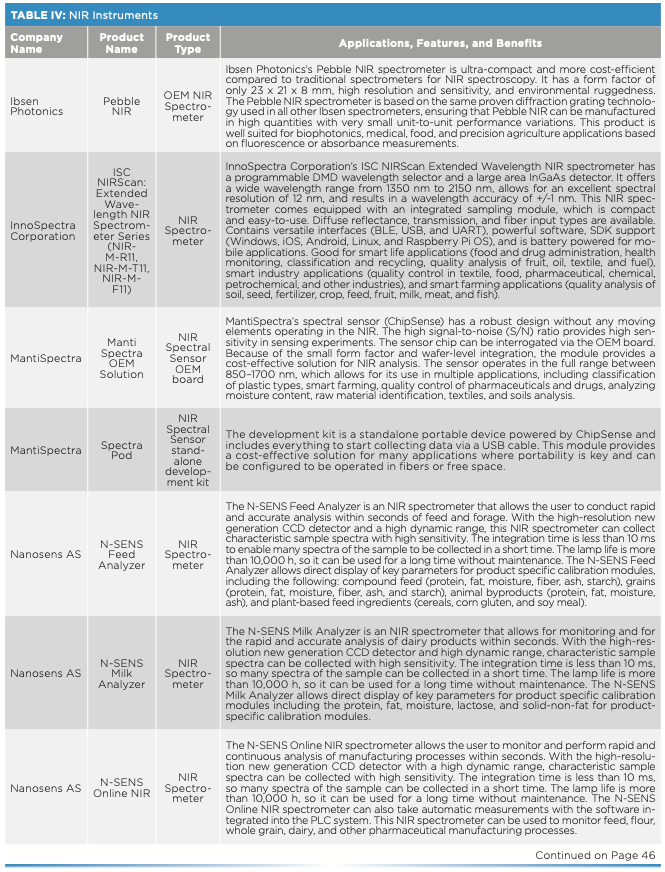

Nanosens AS has introduced three NIR devices, a feed analyzer, a milk analyzer, and an on-line process monitor for industrial use. Norsk Elektro Optikk AS has introduced an NIR hyperspectral imager designed for drone applications that operates in a very wide spectral range from 400 to 2500 nm.
For the smaller NIR engines, there are a number of interesting devices. Ibsen Photonics introduced the Pebble, a vis-NIR device that operates out to 1100 nm and is designed for original equipment manufacturer (OEM) applications. InnoSpectra has extended the range of its NIRScan device, based on the TI digital light processor out to 2150 nm. Manti Spectra has two new offerings: the MantiSpectra SpectraPod and the MantiSpectra OEM solution, both based on the MantiSpectra ChipSense technology and meant for investigation and OEM applications. These four devices illustrate a trend in the NIR world, which is that the development of such devices can be incorporated into monitoring systems to take advantage of the growing NIR applications, and the cloud-based data analysis approach to move the spectroscopy directly to the location of the sample.
In the “mid-infrared (mid-IR)” category (Table V), the traditional suppliers have been busy, and there are several interesting new products. There is a dedicated Silica Analyzer from PerkinElmer, a new general-purpose Fourier-transform infrared (FT-IR) spectrophotometer from Shimadzu, and a nanoscale IR system from Bruker.
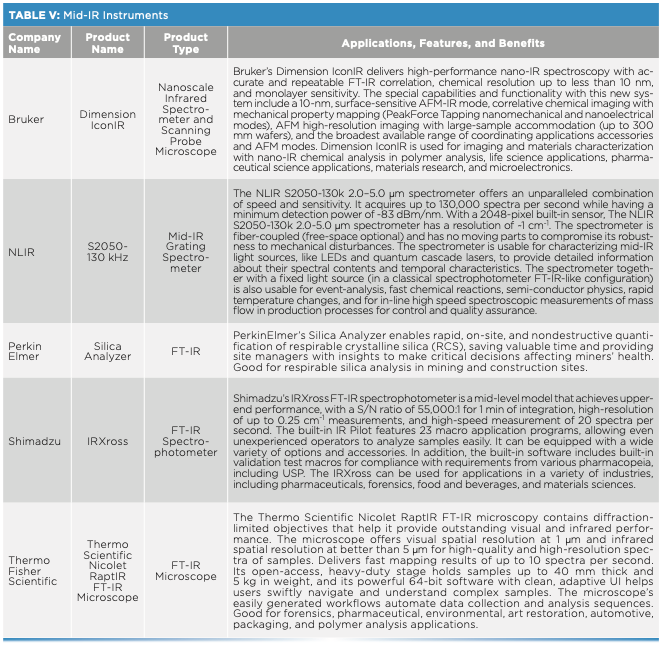
The Bruker mid-IR instrument addresses the growing market to gain IR information from samples that are well below the optical diffraction limit. It incorporates atomic force microscopy (AFM)-IR modes, along with modes typically found in scanning probe microscopy.
A particularly interesting device from the company NLIR Aps is the S2050-130 kHz. This device is a mid-IR grating spectrometer that works in the 2.0–5.0 μm (5000–2000 cm-1) region of the spectrum. It is designed for fast processes and uses the NLIR upconversion technology and a silicon charge-coupled device (CCD) to provide a unique device that can provide data in the mid-IR region.
Thermo Fisher Scientific has introduced the RaptIR for traditional FT-IR microscope analyses. One could debate whether this device belongs here or in the “Accessories” category because you would still need to buy an FT-IR spectrometer for this device to function effectively. However, it is designed to be a workhorse microscope that one would expect to find in a well-equipped industrial spectroscopy laboratory. It also incorporates task-specific workflows (such as microplastic analysis).
Over the past few years, the growth in Raman spectroscopy has been noted multiple times. This continued growth accelerated this year, as Table VI shows, with some exciting new entries. For laboratory-based research instruments, there are two entries that can expand applications into new areas. IS-Instruments has introduced a deep UV Raman system with excitation at 228 nm, capitalizing on the increased Raman scatter (and fluorescence avoidance) with short wavelength excitation. WITec Gmbh has a new cryogenic Raman imaging microscope.
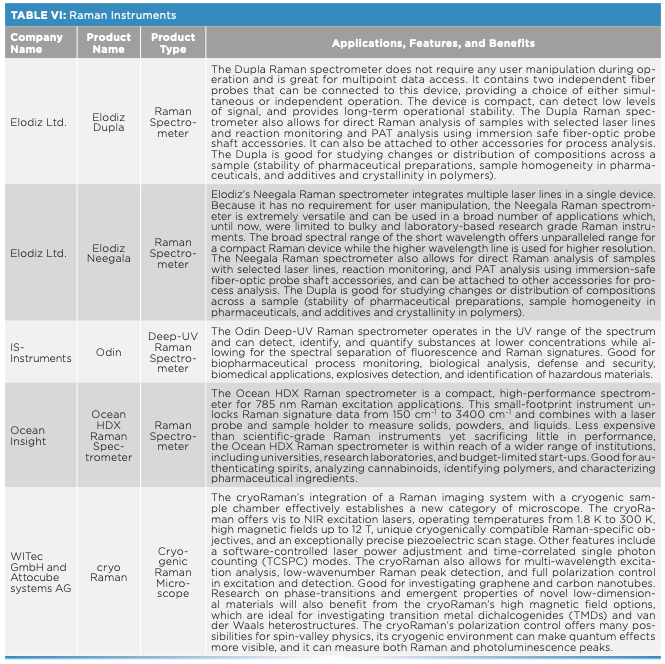
Elodiz, Ltd. and Ocean Insight have introduced devices that are more geared to field and process applications. The two introductions by Elodiz use multiple laser lines and fiber optic probes, whereas the Ocean Insight product continues in the small footprint vein and is designed to detect Raman shifts from 150 to 3400 cm-1 with 785 nm excitation.
Moving on to the “Imaging” category (Table VII) of instruments and components, we have a broad set of products, including several cameras. Greateyes GmbH, Horiba Scientific, Nireos SRL, and Princeton Infrared Technologies, Inc. have all introduced new cameras for imaging applications. EDAX has introduced a new backscatter diffraction detector. Spectrolight Inc. has a new broadband tunable filter that can cover from the UV through to the NIR.
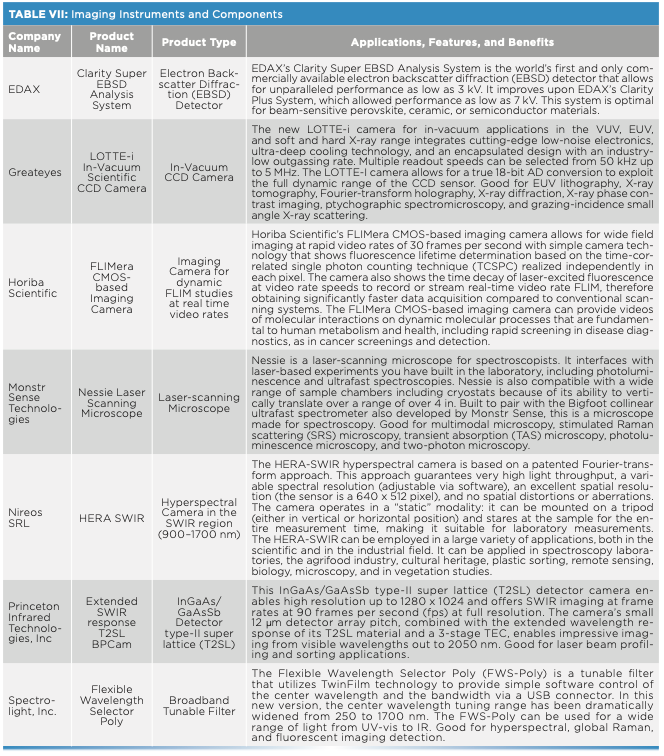
As a complete imaging system, Monstr Sense Technologies has introduced a laser scanning microscope called the Nessie.
The one new product in the nuclear magnetic resonance (NMR) category (Table VIII) is a smaller-footprint NMR spectrometer from JEOL USA.
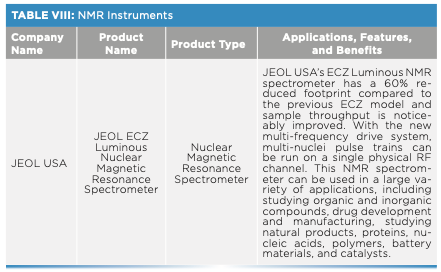
In the “Mass Spectrometry” category (Table IX), two new devices introduced by Refeyn, Ltd, capitalize on the mass photometry technique developed at Oxford University. One of the new instruments is designed to provide automation to the mass photometry technique, whereas the other is optimized for adeno-associated virus characterization.
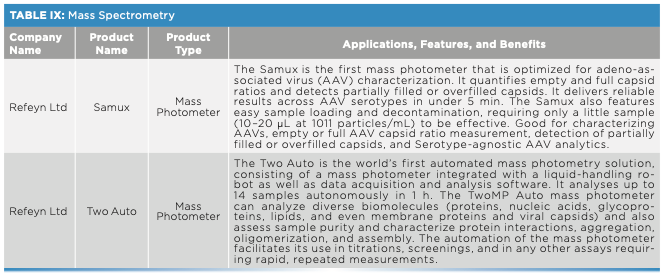
Accessories
In the “Accessories” category, new products have been introduced to simplify sample analysis. REFLEX Analytical Corp. and Nanosens AS have both introduced new cells and cuvettes (Table X). S.T. Japan-Europe GmbH has introduced an improved MicroVice while Specac now provides a heated puck for the Quest. An interesting new product from Specac is the Arrow, which is a disposable silicon ATR accessory.
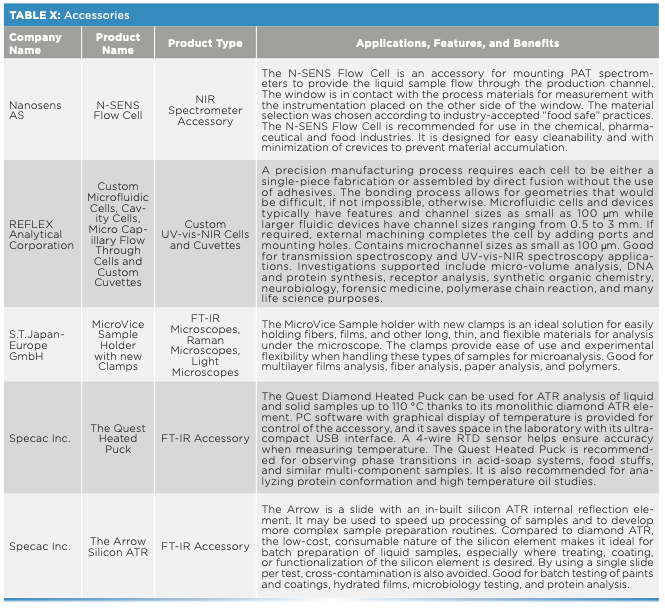
Components
We have defined components as products that would be part of a complete instrument; with that definition, as Table XI indicates, the category includes a disparate set of items.
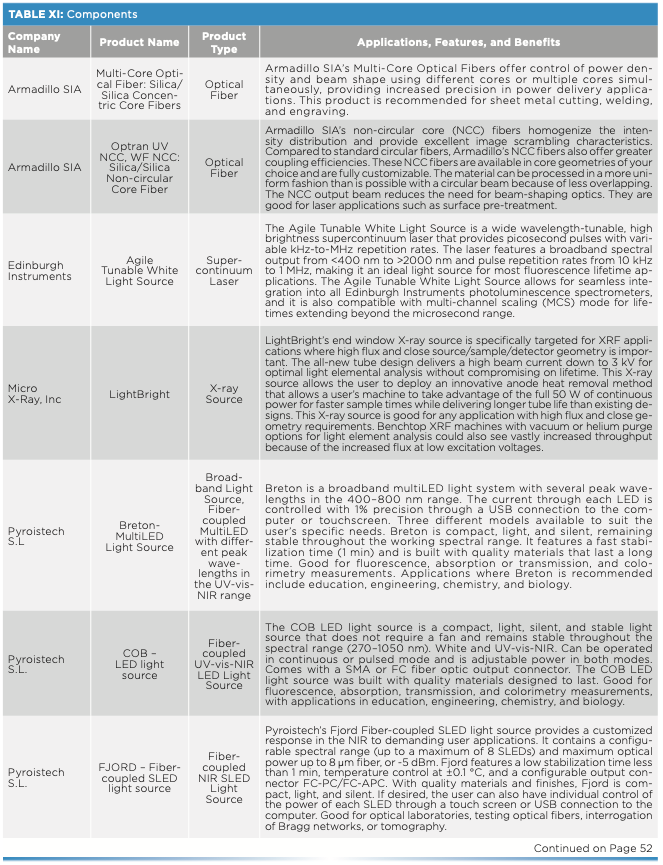

Armadillo SIA has introduced two new optical fiber products while Trace Matters Scientific has a new flexible ion guide. Sources are one type of component where there have been a number of new entries, including products from Pyroistech S.L, Micro X-Ray, Inc., and Edinburgh Instruments.
Software
Anyone who uses instruments recognizes that software is the human interface to the devices. Typically, discussions about new products tend to minimize the effort to develop instrument control software—especially for tried-and-true analytical techniques—in comparison to the focus on the hardware. Many of the instruments mentioned above have new software platforms in addition to the hardware. Both Ocean Insight and Optiwave Systems have introduced driver and instrument control software for their products (Table XII). We are also including spectral libraries in the software category. S.T. Japan-Europe GmbH has introduced three new libraries, a microplastics IR library, and a Raman microplastics database. They also have introduced a Raman database for psychoactive and illicit drugs.
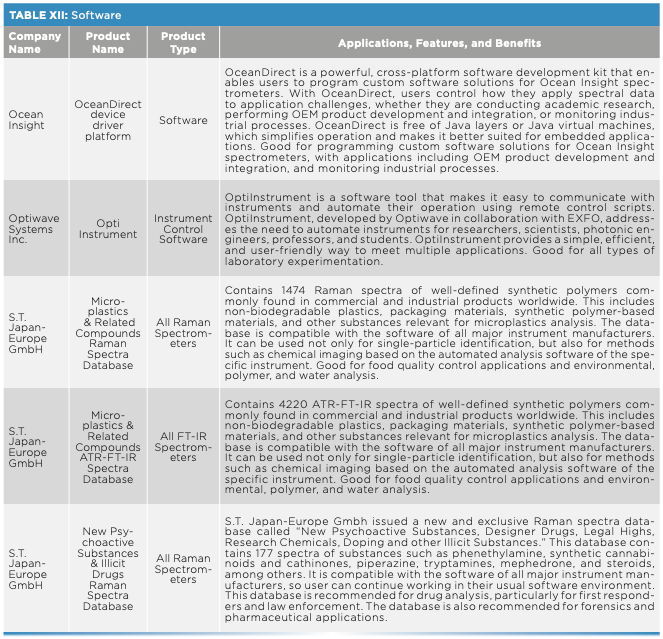
Trends and Conclusions
Many of the products discussed in this review seem to follow trends that we have seen in analytical instruments in recent years. The products are becoming smaller, easier to use, and, in many cases, specific to a particular application rather than for a general purpose. Likewise, tools that are making data easier to acquire or interpret are a major thrust of instrument companies and those approaches will increase the productivity of users in the laboratories. Although we applaud these trends, we hope that the audiences for these products are cognizant of how each device works, what data it should deliver, and how to interpret the data—rather than relying on a “black box” approach. The real danger with such easy-to-use tools lies in relying on the vendor to supply the analytical result; a critical part of integrating any analytical instrument into a laboratory is validation.
With the pandemic waning (we hope), in the coming year we believe that the pace of product introductions will pick up. We look forward to seeing new devices in person at conferences.
Submit Your Products As Your Launch Them
If your organization introduces a new product in the coming months, please tell us right away by submitting the 2023 Spectroscopy New Product form, which can be found at https://www.spectroscopyonline.com/view/spectroscopy-new-product-review. We will accept submissions as products are introduced and will include the appropriate products in the 2023 review.
Ellen Miseo is a consultant in vibrational spectroscopy and spectroscopy education. She is the past president of both the Coblentz Society and the Society for Applied Spectroscopy, and serves on the Spectroscopy Editorial Advisory board. Michael S. Bradley also serves on Spectroscopy’s Editorial Advisory Board and is a Product Manager at Thermo Fisher Scientific in Madison, Wisconsin. Direct correspondence to: SpectroscopyEdit@mmhgroup.com. ●
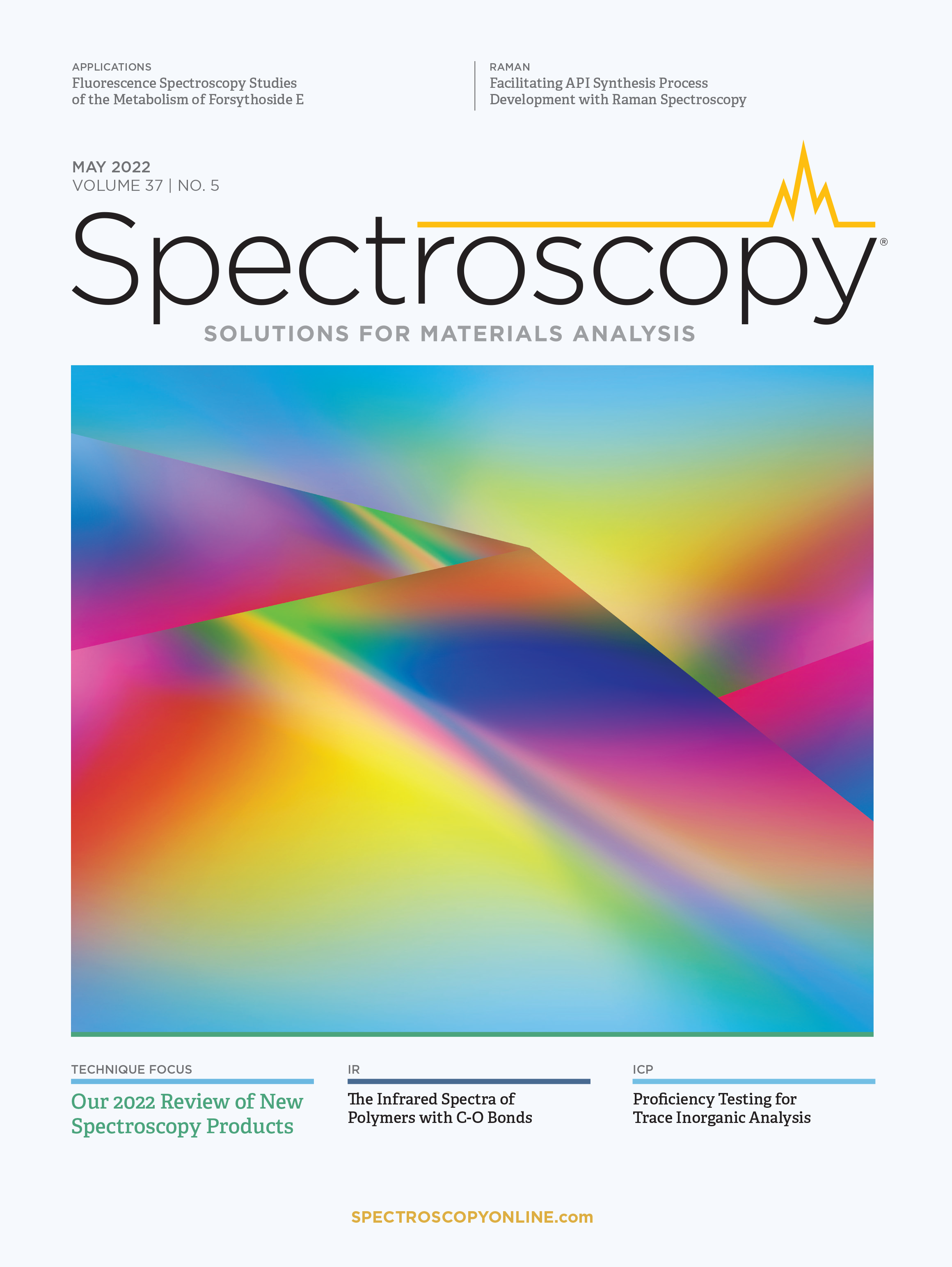
LIBS Illuminates the Hidden Health Risks of Indoor Welding and Soldering
April 23rd 2025A new dual-spectroscopy approach reveals real-time pollution threats in indoor workspaces. Chinese researchers have pioneered the use of laser-induced breakdown spectroscopy (LIBS) and aerosol mass spectrometry to uncover and monitor harmful heavy metal and dust emissions from soldering and welding in real-time. These complementary tools offer a fast, accurate means to evaluate air quality threats in industrial and indoor environments—where people spend most of their time.
Trends in Infrared Spectroscopic Imaging
September 13th 2013An interview with Rohit Bhargava, winner of the 2013 Craver Award. This interview is part of the 2013 podcast series presented in collaboration with the Federation of Analytical Chemistry and Spectroscopy Societies (FACSS), in connection with SciX 2013, the federation?s North American conference.
NIR Spectroscopy Explored as Sustainable Approach to Detecting Bovine Mastitis
April 23rd 2025A new study published in Applied Food Research demonstrates that near-infrared spectroscopy (NIRS) can effectively detect subclinical bovine mastitis in milk, offering a fast, non-invasive method to guide targeted antibiotic treatment and support sustainable dairy practices.
High-Speed Laser MS for Precise, Prep-Free Environmental Particle Tracking
April 21st 2025Scientists at Oak Ridge National Laboratory have demonstrated that a fast, laser-based mass spectrometry method—LA-ICP-TOF-MS—can accurately detect and identify airborne environmental particles, including toxic metal particles like ruthenium, without the need for complex sample preparation. The work offers a breakthrough in rapid, high-resolution analysis of environmental pollutants.